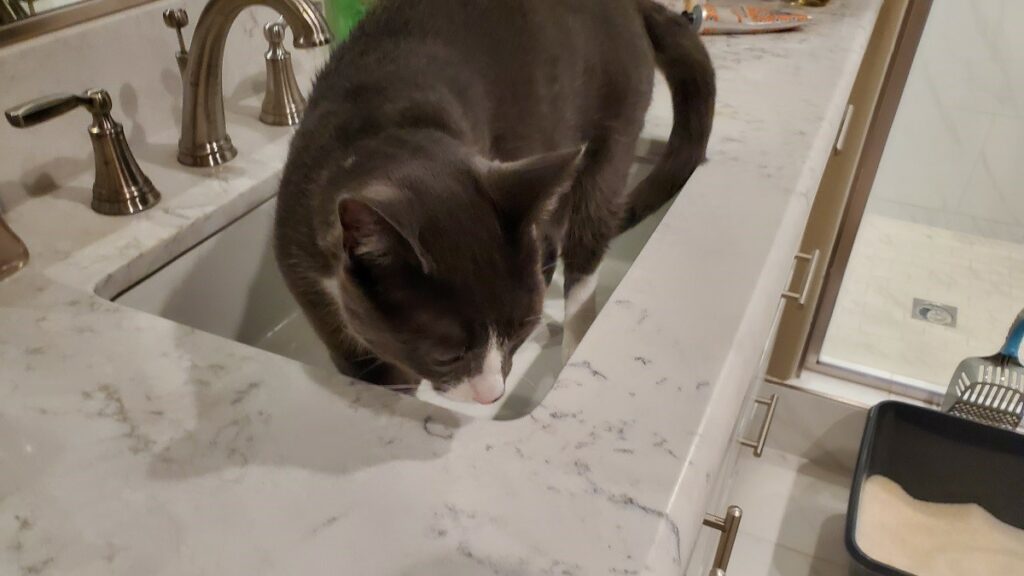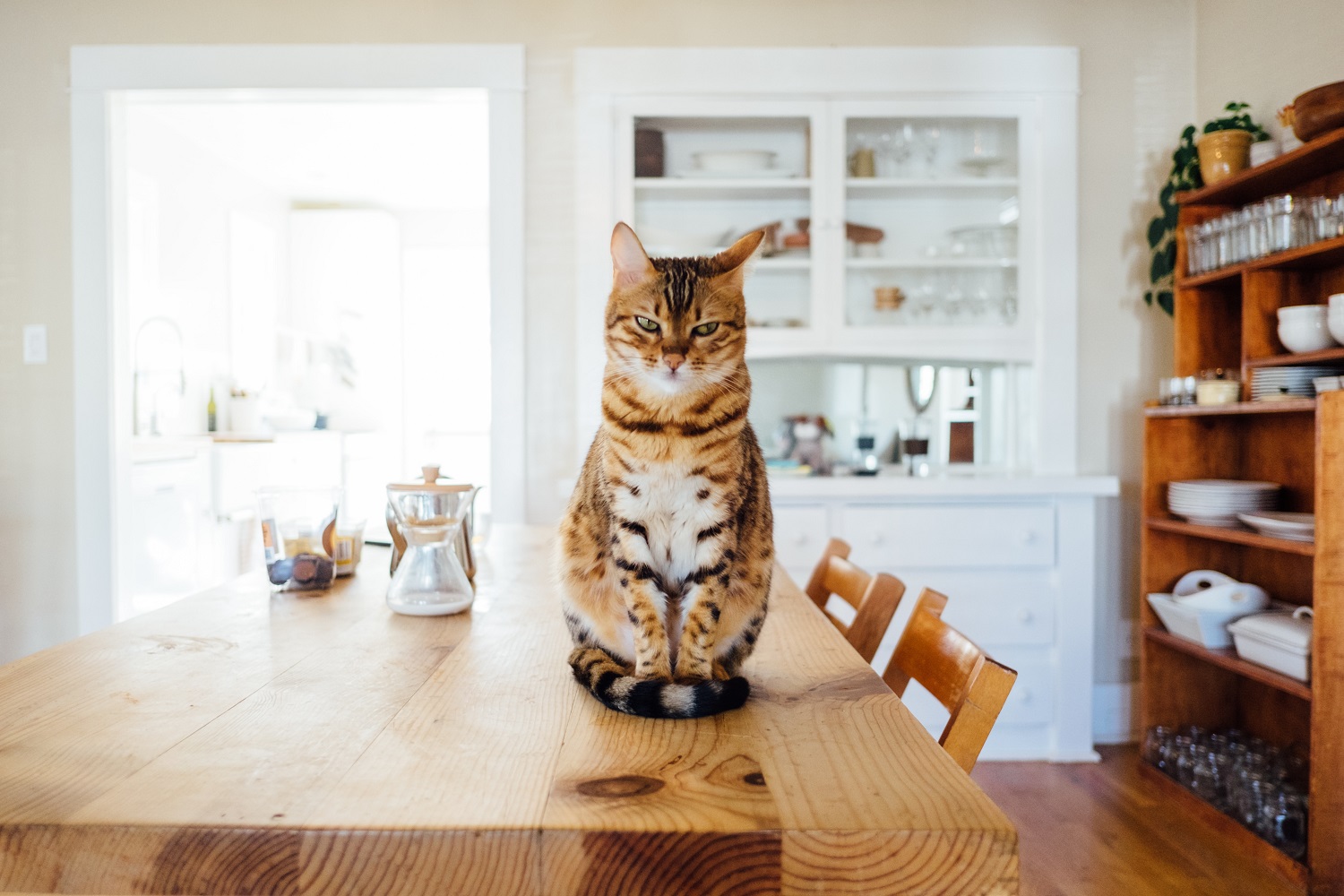Your cat is sweet, affectionate, and possibly training to be a parkour champion. You leave the room for five seconds, and somehow they are sitting on the dining table like they pay rent. If you are constantly trying to keep paws off countertops, you are not alone.
Keeping cats off tables and counters is a common challenge for pet owners, and it is not about bad behavior. It is about instincts. Cats love to be up high, and your furniture just happens to make the perfect jungle gym.
The good news is, you can redirect this climbing habit without turning your kitchen into a fortress. It starts with understanding why your cat is up there in the first place.
Why Cats Love to Climb on Tables and Counters
Cats are built for climbing. Their bodies are designed to leap, perch, and observe from above. In the wild, high ground gives cats a better view of their surroundings and helps them feel safe from predators or rival animals.
In your home, your cat is not avoiding tigers, but the instinct to seek vertical space is still strong. And guess what? Your counters check all the boxes: they are high, flat, often near windows, and sometimes smell like chicken.
The most common reasons cats jump on surfaces include:
- Curiosity about food or smells
- Access to running water or sinks
- A better view of their territory
- Seeking attention or entertainment
- Lack of other climbing opportunities
The key to stopping the behavior is not punishment. It is about offering alternatives and making counters less appealing.
Why Punishment Doesn’t Work
It is tempting to clap, squirt water, or yell when your cat hops onto the counter for the fifteenth time. But here is the thing: punishment rarely works with cats the way we want it to.
Cats do not always connect your reaction to the behavior, especially if there is a delay. They might just learn that counters are fine when you are not around, or worse, they might start associating you with unpredictable negative reactions.
Instead, the goal should be to redirect and discourage the behavior in ways that make sense to your cat.
How to Keep Cats Off Counters and Tables
There is no one-size-fits-all solution, but a combination of these strategies usually does the trick.
1. Provide acceptable climbing alternatives
If your cat wants to be up high, give them something that is actually meant for climbing. Tall cat trees, wall shelves, or window perches let them satisfy that instinct without invading your food prep zone.
2. Keep surfaces clean and uninviting
Wipe down counters regularly to remove food smells, crumbs, and grease. If it smells like a snack, your cat will treat it like one. Keep tempting items like bread, meat, or butter out of reach.
3. Make the space uncomfortable
Cats dislike certain textures under their paws. Try placing aluminum foil, double-sided tape, or a crinkly plastic mat on counters when not in use. These materials make walking uncomfortable, which reduces the appeal over time.
4. Block access to temptation zones
If your cat jumps up to reach the sink or a specific window, close the blinds, block the view, or offer a better alternative nearby. If there is no reward at the top, they are less likely to try.
5. Use positive reinforcement
Reward your cat for choosing their cat tree, shelf, or bed instead of the table. Treats, praise, or a short play session can help reinforce the behavior you want to see more of.
6. Establish no-go zones early
If you are starting with a kitten or a new cat, be consistent from day one. Do not let them on the counters “just this once.” Cats are creatures of habit, and a little consistency goes a long way.

Oh, the thrill of scaling these towering countertops! My humans think they can keep me from reaching these lofty heights, but little do they know, I’m the ultimate feline acrobat. Aluminum foil? Bubble wrap? Puh-lease. I mean, seriously, #TryHarder. #CounterKing #LivingOnTheEdge #CountertopAdventures #KittiesRule #NoSurfaceIsSafe
Winston
When to Be Concerned
Occasionally, excessive climbing can be a sign of boredom, anxiety, or unmet needs. If your cat seems restless, destructive, or overly focused on countertops despite having plenty of alternatives, take a closer look at their environment.
Make sure they have:
- Enough daily playtime and stimulation
- Access to windows, toys, and scratching posts
- A consistent feeding routine
- Time with you for social connection
Sometimes the behavior is not about the counter. It is about attention or activity that is missing elsewhere.
Final Thoughts: Your Cat Is Not Being Naughty, They Are Just Being a Cat
Keeping cats off tables and counters takes patience, consistency, and a little creativity. You are not dealing with a stubborn pet. You are working with a creature whose instincts tell them that being up high is safe, fun, and interesting.
By providing appealing alternatives and removing the rewards from off-limits areas, you can shift your cat’s behavior without a power struggle. Over time, they will learn where they are allowed to go and where they are not.
And if all else fails, at least you will never be surprised by your cat’s vertical leap again.
Sources:
Why Cats Love High Places https://www.icatcare.org/advice/why-do-cats-like-high-places
Feline Behavior and Training https://vcahospitals.com/know-your-pet/training-your-cat-to-stay-off-counters
Environmental Enrichment for Cats https://www.humanesociety.org/resources/enriching-your-cats-life
How to Stop Cats from Jumping on Counters https://www.petmd.com/cat/behavior/how-stop-cat-jumping-counter
Recent Posts
Your Cat Might Be a Furry Little Healer… or at Least a Fuzzy Alarm System If you’ve ever had your cat suddenly become extra clingy when you’re under the weather, you’re not alone. From...
Cats are experts at hiding things, socks under furniture, their disdain for your playlist, and, unfortunately, symptoms of illness. In the wild, showing weakness could make them a target, so even...


